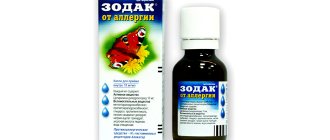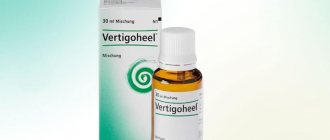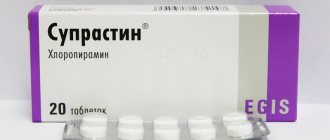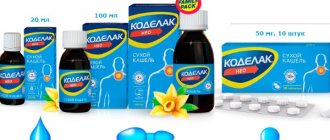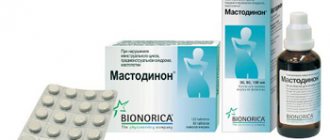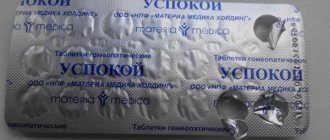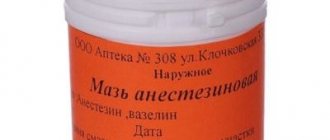Chemical composition
The basis of the drug is cetirizine dihydrochloride. There are 10 mg of product per 1 ml. It is what destroys the irritants of the allergic reaction. It fights both in the initial form of the disease and against chronic disease.
The drops also contain auxiliary ingredients:
- methyl 4-parahydroxybenzoate;
- propyl parahydroxybenzoate (syrup);
- propylene glycol;
- glycerol (85%);
- saccharin;
- sodium salt of acetic acid;
- concentrated acetic acid;
- water without impurities.
Detailed instructions for using Zodak drops for children are given in the article.
With the help of components, the effect of the main substance and the duration of the drug’s functioning are enhanced. They also extended the shelf life.
Diazolin or Zodak?
Diazolin contains mebhydrolin as a medicinal component. The medicine is commercially available in pills and tablets produced by various companies. Therefore, the age at which it can be used must be clarified in the official instructions, since it differs depending on the manufacturer. Typically, Diazolin in a dose of 50 mg can be taken from 3 years of age. This antihistamine is recommended for a runny nose of allergic origin, hay fever, and allergic skin reactions.
The drugs Diazolin and Zodak differ in composition, contraindications and side effects, and the doctor must decide which one is better for each child individually.
Production form
Zodak is available in the form:
- pills;
- drops;
- syrup.
Drops are dispensed from pharmacies in glass, darkened bottles (usually dark brown containers), 20 ml in volume, they are transparent or have a light yellow tint, and are odorless.
Under the main cover there is a dropper dispenser (for ease of counting drops). The cap is equipped with child protection (without pressing the cap, the bottle cannot be opened). After pressing, the container opens as standard.
Composition, description, release forms
Zodak drops are sold in pharmacies in small bottles of 20 milliliters. Each milliliter is approximately twenty drops of the drug.
Depending on the doctor’s prescriptions, each mother can estimate how long one bottle will last her.
The medicine is transparent, sometimes with a slight yellowish tint. The active ingredient in it is cetirizine dahydrochloride.
To an uninitiated person who has never suffered from allergies, this name means little, but experts know it well as a drug that quickly gives the patient relief and prevents the development of allergic symptoms in the future.
Among the excipients included in Zodak:
- water;
- glycerol;
- acetic acid;
- propylene glycol (dihydric alcohol).
Many mothers also know about the existence of Zodak syrup and often wonder: why not replace the drops with a sweet syrup that is more pleasant for the baby.
However, it is necessary to strictly follow the doctor’s recommendations, because there is still a difference between the two types of the drug: the concentration of the active substance in the syrup is higher than in the drops.
When writing a prescription, the doctor must take this and other features of the medicine into account.
Pharmacological properties
Instructions for using Zodak drops allow them to be taken by children starting from 1 year old, but under the supervision of a pediatrician it is possible earlier. This antiallergic pharmaceutical drug belongs to the group of 2nd generation medications. The drops have a longer lasting effect than some of its analogues.
Cetirizine suppresses H-receptors (they are the culprits of allergies). Has no strong side effects. Quickly relieves inflammation, swelling and itching.
Drops at the initial stage of allergies immediately reduce symptoms. Does not allow the disease to worsen. Helps get rid of muscle spasms, strengthens capillaries. This makes it more difficult for the allergen to spread throughout the body, reducing the risk of developing edema. Does not have a sedative effect and does not cause drowsiness.
Drops relieve hives. They play a positive role in cases of runny nose or asthma, as they relieve swelling. The effectiveness of the drug is high at any age. Zodak copes well even with chronic allergies; you can take drops all year round (at intervals, the dosage is prescribed by your pediatrician).
The allergic reaction begins to subside after 20 minutes, maximum after an hour (when taking the medicine was associated with food). The effect may last for 24 hours.
Suprastin or Zodak?
The therapeutic effect of Suprastin is explained by chloropyramine. In the pharmacy it comes in tablets and injections, which can be given to children older than one month with various types of allergies, especially those accompanied by skin manifestations. The medication is contraindicated in case of intolerance or an attack of bronchial asthma. Its main difference from Zodak is that Suprastin very often causes a pronounced sedative effect.
It is not very correct to compare these two antiallergic drugs, since they have different compositions, contraindications and undesirable effects.
Pharmacodynamics
The main substance (cetirizine) is a metabolite of hydroxyzine. Its main property is the suppression of histamine H1 receptors. The drug effectively eliminates symptoms (swelling, rash, runny nose, etc.), and also alleviates and prevents the occurrence of allergies.
The suspension is quickly absorbed by the body, and, binding to protein in the plasma, spreads throughout the body. The drug is excreted through the kidneys, 10 years after entering the body. If there are problems with the kidneys (not serious), then withdrawal of the medicine may take longer. When taking a course of drops (10 days), the substance does not accumulate in the blood.
If Zodak was taken with food, the time for the pharmaceutical to be absorbed and begin to work increases. The product fights not only allergic rashes and eliminates itching, but also helps relieve swelling in internal organs (this is the most dangerous thing with allergies).
Testing of the drug has shown effectiveness at different ages (in children) and with different forms of allergic reactions. Children under one year of age did not participate in the tests. At such a young age, the drug is allowed to be taken under the supervision of a pediatrician. He prescribes the number of drops depending on the baby’s weight and the severity of the allergy.
Indications and effect of the drug
Zodak can be used to treat acute and chronic allergic conditions. It is prescribed for rhinitis (seasonal and year-round) to eliminate:
- itching and sneezing;
- swelling of the mucous membrane of the respiratory tract and facial skin;
- lacrimation, inflammation and redness of the conjunctiva caused by contact with the allergen;
- allergic dermatosis with rashes and blisters that are constantly renewed.
The active ingredient of the medicine is cetirizine. This substance is a histamine receptor antagonist. It prevents the binding of histamine to the receptor, disrupts their interaction, thereby inhibiting the work of the biogenic amine. Cetirizine prevents the physiological effect of high histamine levels in the body.
Once in the blood, Zodak reduces the sensitivity of the immune system to allergen exposure. The medicine effectively inhibits the development of allergic reactions, which can greatly alleviate the patient’s condition. The medication reduces the sensation of itching and prevents the release of fluid into the intercellular space at the site of inflammation.
Zodak prevents the formation of blisters in the early stages of an allergic response. The drug prevents the appearance of edema. It does not allow skin thickening and redness to develop in the later stages of an allergic reaction. The active substance Zodak prevents the release of inflammatory mediators, the presence of which leads to a local increase in temperature.
The drug reduces the speed of movement of leukocyte cells through the bloodstream into the area of inflammation:
- eosinophils;
- segmented basophils;
- neutrophils.
Slowing down the migration of leukocytes leads to a decrease in skin manifestations in the form of rashes and swelling. The drug relaxes smooth muscles, relieves bronchospasm, and reduces the permeability of small blood vessels. Zodak reduces the manifestation of cold urticaria.
Pharmacokinetics
The drug is taken orally, enters the stomach, and then penetrates into the blood. After interacting with protein, it spreads throughout the body. The highest cetirizine content was observed after 30-90 minutes. after use, but if the drops were taken with food, the absorption time will increase. This will not affect the effect of the drops.
Once in the body, the main substance is not metabolized in the liver. Cetirizine is excreted by the kidneys (in its original form). Cetirizine does not accumulate in the body.
But if there are kidney diseases, then the active substance may not be completely eliminated and will begin to have a toxic effect on all organs and tissues. The average time for drug removal from the body is from 3 hours (in children) to 10 hours (in adults). It should be taken with special caution if you have liver problems. Consultation with a gastroenterologist or pediatrician is required.
Indications for use
Zodak drops (instructions for use for children contain a list of diseases for which the medicine is effective) are recommended for use for the following allergic phenomena:
- seasonal exacerbations of the runny nose and suppuration of the eyes;
- rashes accompanied by itching;
- hay fever;
- various types of urticaria;
- Quincke's edema;
- swelling of the mucous membrane;
- cough, sneezing;
- bronchial asthma.
Drops in 10-20 minutes. relieve the above symptoms. Admission is allowed from one year of age. For younger children, consult a pediatrician.
Use in elderly patients
Zodak® tablets are not prescribed to children under 6 years of age.
In elderly patients at risk of renal pathologies or dysfunction, the drug is prescribed with a reduced dosage.
According to the instructions, Zodak tablets have the following indications:
- allergic rhinitis (itching, nasal congestion, sneezing, excessive nasal mucus) - year-round and seasonal;
- ocular allergic symptoms (itching, lacrimation, conjunctival hyperemia);
- chronic idiopathic urticaria (itchy, swollen rashes on the skin).
Let us list the restrictions on the use of the drug in question:
- the presence of individual sensitivity to the components of the tablets, hydroxyzine and other piperazine derivatives;
- severe renal failure (end stage);
- hereditary galactose intolerance, lactose deficiency, malabsorption syndrome;
- age up to 6 years (for this form of the drug).
In addition, it is known that these tablets should be used with caution by people who have an increased risk of urinary retention or seizures (including epileptic seizures). Caution should also be exercised when taking alcohol-containing drugs and other drugs that depress the activity of the central nervous system.
Many female patients are concerned about the question of whether Zodak can be used for allergies during pregnancy and breastfeeding. According to available data, experimental studies have not revealed any cases of negative effects with a clear cause-and-effect relationship on the developing fetus (including in the postnatal period), on the course of pregnancy and delivery.
However, due to the lack of regulated, strictly controlled clinical trials involving pregnant women, no pregnant women have been conducted, which is why pregnant women should still refuse to use it. As for the period of breastfeeding, due to the fact that the active component of the drug enters the milk in a significant concentration, it can be used by nursing mothers only in urgent cases, in especially severe cases.
Contraindications
Zodak drops stand out among other drugs for their safety, but there are still a number of cases when it may be contraindicated.
When drops are contraindicated:
- During pregnancy and breastfeeding.
- Children under 1 year old.
- Intolerance to one of the components of the drug.
- Problems with the kidneys.
- If there are spasms in the bronchi and a strong cough.
- Epilepsy and other diseases accompanied by seizures.
Additional instructions for taking the medication:
- It is not recommended to combine the use of drops with sedatives.
- Alcoholic drinks are excluded during the treatment period.
- Take the drops especially carefully in case of illnesses associated with difficulty urinating.
- For elderly people, the dosage, like for children under one year of age, is prescribed by a doctor.
- For premature babies, only a pediatrician can prescribe the drug (especially the dose).
- If the mother smokes, drinks, or uses drugs, then taking the drug can harm the child’s body.
- When the mother is under 19 years old, take the drug under the supervision of a doctor. Children from minor mothers have much weaker bodies and side effects may occur.
The medicine is allowed to be taken by people with diabetes. Since glucose is not included in the zodak, saccharin replaces it.
special instructions
Caution should be exercised if the patient drinks alcohol during treatment with Zodak® or if the patient is simultaneously taking medications that depress the central nervous system.
Patients who have noted the appearance of lethargy and/or drowsiness during treatment are not recommended to drive vehicles or engage in activities that require concentration, concentration, and quick reactions.
In patients with disorders of the spinal cord, with prostate adenoma, as well as if they have other risks of developing urinary retention, Zodak® should be prescribed with caution due to the possible likelihood of this complication.
In patients with seizures, including those with increased readiness to seizures, and epilepsy, cetirizine should be used with caution.
Before conducting allergy tests, it is recommended to discontinue the drug for three days so that cetirizine ceases its inhibitory effect on allergic reactions from the skin.
Due to the presence of auxiliary components in the film shell, Zodak® tablets are not prescribed to patients with hereditary galactose intolerance, lactase deficiency, or glucose-galactose malabsorption syndrome.
In some cases, cessation of treatment with cetirizine may be accompanied by the appearance of urticaria, even if this disease was not the reason for prescribing the drug. When treatment with the drug is resumed, the urticaria disappears. If the manifestations of this reaction are too pronounced, re-prescription of the medication is required.
Zodak® tablets are not prescribed to children under 6 years of age.
Instructions for use, dosage for infants, children up to one year old
Zodak drops are allowed to be taken by children starting from the 2nd year of life. The instructions for use contain information about taking the drug for children from 6 months, but the product can be used at this age only with the permission of the pediatrician. He will prescribe a daily and one-time dosage for the baby.
Give drops to children only in diluted form (with water or some other drink). The amount of liquid should be in a 1:1 ratio (no less, more is possible). The main thing is that the child can take the drug at one time.
Take the prepared solution immediately, do not store.
Food intake does not play a significant role in the effectiveness of the medicine. Only on the absorption of the drug (it will increase). During the course of treatment, it is recommended to take the drops at the same time. The dosage and duration of treatment depends on age, health status and the course of the disease itself. The baby's weight also plays an important role.
| Child's age | Single dosage mg/drops | How many times a day | Time of receipt |
| 6 – 12 months | 2,5/5 | 1 | Morning |
| From 1 year to 2 years | 2,5/5 | 2 | Morning evening |
| From 2 to 6 years | 2,5/5 | 2 | Morning evening |
| From 6 to 12 years old | 5/10 | 2 | Morning evening |
| From 12 years and older | 10/20 | 1 | Morning |
Sometimes, after 2 years, a child may only need 5 mg/10 drops per day. If the desired result is achieved, then there is no need to increase the dosage to that indicated in the table.
If there are kidney problems, the dosage is reduced by 2 times. In case of liver dysfunction, no special changes in taking the medication are required. But consultation with a pediatrician or gastroenterologist is necessary.
If both diseases are present, self-administration is prohibited. Be sure to consult with specialists. After each dose of the drug, be sure to close the bottle tightly. This is done for the safety of the child (if he gets there, he won’t open it), and the drops retain their medicinal properties longer.
Side effects
All of the following side effects were observed extremely rarely. And most often the cause was an overdose of the drug.
Possible adverse reactions:
- decreased platelet levels and blood clotting;
- excited state, aggressiveness;
- depression, confusion;
- insomnia or drowsiness;
- hallucinations;
- memory loss;
- convulsions;
- change in taste;
- loss of visual acuity, images lose clarity;
- increased heart rate;
- loose stools;
- nausea, possible vomiting;
- increased appetite;
- urticaria, medicinal erythema;
- problems with urination;
- patient weight gain;
- increased concentrations of liver enzymes in the blood;
- migraine, dizziness.
If side effects occur, it is recommended to rinse the stomach with activated charcoal. After this, seek help from the nearest hospital.
Erius or Zodak?
The therapeutic effect of Erius is explained by desloratadine. The drug is sold in syrup, regular and absorbable tablets. In liquid form, Erius is allowed for patients who are six months old, lozenges are allowed from 6 years old, and coated tablets from 12 years old.
The drugs have common indications, but they have different contraindications and side effects, so the doctor must decide which one is better.
Overdose
Zodak drops (instructions for use for children contain information on the dosage of the product) should be used according to the instructions to avoid overdose. When a single dosage exceeds 100 drops, you may encounter complications.
Deviations in the functioning of the nervous system:
- the child is in an excited state;
- becomes weak, constantly wants to sleep;
- tremor of the limbs;
- confusion of consciousness;
- inhibition of actions;
- headaches, dizziness;
- may fall into a stupor.
Deviations in the digestive tract:
- pain in the stomach;
- dry mouth;
- diarrhea or constipation.
Deviations in the functioning of the heart - rapid pulse. Deviations in the functioning of the kidneys - delayed urine output. In rare cases, itching has been reported. If an overdose of the drug occurs, it is recommended to immediately lavage the stomach and induce vomiting.
After rinsing, it is recommended to give activated charcoal so that it absorbs the remaining medication from the gastrointestinal tract. There are no drugs known yet that neutralize the effect of Zodak drops.
Prices in pharmacies in Moscow, St. Petersburg, regions
In cities, the cost of the drug varies. And even in the same city, the price can be different in different pharmacies. Depends on the surcharge for drug delivery. Below is a table of prices in different cities. Zodak drops are sold in standard packaging of 20 ml. The manufacturer is a company in the Czech Republic.
| City | Prices, rub. |
| Moscow | 170 — 210 |
| Arkhangelsk | 140 — 180 |
| Blagoveshchensk | 155 — 195 |
| Vladivostok | 140 — 200 |
| Volgograd | 140 — 200 |
| Ekaterinburg | 145 – 220 |
| Krasnodar | 150 — 210 |
| Novosibirsk | 160 — 220 |
| Permian | 165 — 190 |
| Saint Petersburg | 140 — 220 |
| Sochi | 140 — 215 |
| Ufa | 160 — 200 |
| Khabarovsk | 140 — 200 |
The average price for drops varies between 180-195 rubles.
Name of the drug Zodac Zodac
- Active ingredient: 10 mg of cetirizine in 1 capsule or 20 drops and 5 mg in 1 dosing spoon of suspension.
- Excipients:
- The drops contain methyl ester of para-hydroxybenzoic acid, glacial ethanoic acid, propyl ester of para-hydroxybenzoic acid, propanethriol, propylene glycol, sodium salt of ethanoic acid, saccharinate, distilled water.
- Tablets include milk sugar, corn glycogen, polyvinylpyrrolidone, magnesium stearate. The shell contains hydroxypropyl methylcellulose 2910/5, polyethylene glycol 6000, steatite, titanium dioxide, simethicone.
- The syrup in 1 scoop contains para-hydroxybenzoic acid methyl ester, saccharin, para-hydroxybenzoic acid propyl ester, propylene glycol, glycerol, glacial ethanoic acid, glucite, sodium ethanoic acid, banana flavor and distilled water.
- Pharmacotherapeutic group: H1-histamine receptor blocker.
- ATC code: R06AE07 Cetirizine.
- Release form:
- Zodak in coated tablets has a white tint. Available in blisters of 7 and 10 medicinal units each. The medication comes with instructions for using Zodak in tablets and is placed in a branded cardboard box.
- The syrup is a colorless liquid with a creamy tint. Available in 100 ml bottles made of dark opaque glass. The drug comes with instructions for use of Zodak and a dosing spoon, which are placed in a branded cardboard package.
- Zodak drops for oral administration are a colorless liquid with a yellow tint in 20 ml bottles. The bottle is equipped with a dispenser and a screw cap. The medicine comes with instructions for using Zodak in drops and is placed in a branded cardboard box.
- Storage conditions: Storage temperature from 10 to 250C in a place inaccessible to children and excluding exposure to ultraviolet rays. The shelf life of the drug from the date of production is 3 years.
- Terms of sale: over the counter.
- Manufacturer: Zodak is produced by the Czech pharmaceutical and German company A. Nattermann & Hsieh. GmbH".
Analogues of the drug
Analogues to zodak drops are of 2 types: direct or indirect. Direct analogues are drugs containing cetirizine. They may contain a different concentration of the active substance. The composition of the auxiliary components also differs. Before taking, be sure to read the instructions, especially the dosage and use.
| Drug name | In what form is it produced? | Age category | Amount of cetirizine (mg) |
| Letizen | Coated tablets | From 6 years old | 10 |
| Zyrtec | Drops with a sour odor | From 6 months | 10 |
| Parpazin | Drops with a faint vinegar odor | From 1 year | 10 |
| Tsetrin | Coated tablets | From 6 months | 10 |
| Allertek | Drops, tablets, syrup | From 6 years old | 10 |
| Zintset | White coated tablets | From 2 years | 10 |
| Alerza | White or cream coated tablets | From 6 years old | 10 |
Their effect on the body is not very different from zodak drops. The main difference is the price and age category, different types of release. Indirect analogues are drugs in which the active substance is not cetirizine, but their purpose is to relieve the patient of allergies. It is also necessary to read the instructions.
| Drug name | In what form is it produced? | Active ingredient | General purpose | Age category | Amount of active substance |
| Nasonex | Spray in the form of a white suspension | Mometasone furoate | Getting rid of allergic rhinitis | From 2 years | 50 mcg |
| Tavegil | White pills | Clemastine hydrofumarate | Any type of allergic reaction | From 6 years old | 1 mg |
| Avamis | Spray in the form of a white suspension | Fluticasone furoate | Allergic runny nose and eye problems due to allergies (lacrimation, suppuration) | From 2 years | 27.50 µg |
| Suprastin | White or gray tablets | Chloropyramine hydrochloride | Any type of allergic reaction | From 3 years | 25 mg |
| Vibrocil | Transparent drops with lavender scent | Phenylephrine, dimethindene maleate | Allergic runny nose | From 1st year | 2.50 mg, 0.25 mg |
| Galazolin | Drops/gel | Xylometazoline hydrochloride | Allergic runny nose | From 2 years / from 3 years | 500 mcg |
| Nazivin | Drops/spray | Oxymetazoline hydrochloride | Allergic runny nose | From 1st month | 500 mcg |
| Tizin | Spray in the form of a white suspension | Levocabastine hydrochloride | Allergic runny nose | From 6 years old | 500 mcg |
| Erius | Orange clear syrup | Desloratadine (micronized) | Allergic runny nose/rash | From 1st year | 500 mcg |
| Fenistil | Transparent drops, odorless | Dimetindene maleate | Any type of allergic reaction | From 1st year | 1 mg |
| Claritin | White tablets | Loratadine | Any type of allergic reaction | From 2 years | 10 mg |
The drugs can replace Zodak drops if they are not available in the pharmacy or there are contraindications to the components of the drug. The pediatrician should change the Zodak drops to another medicine. He will select a product with a more suitable composition. Prescribe a course of treatment. Since sometimes you should deviate from the instructions, depending on the condition and weight of the baby.
Zyrtec or Zodac: what to give your child?
Zyrtec is an original drug produced in Switzerland, the therapeutic effect of which is explained by cetirizine. It is commercially available in drops and tablets. The drug should not be given in liquid form to children under six months of age. Tablets are prohibited for patients under 6 years of age. Zyrtec, regardless of the form of release, is contraindicated in cases of severe renal failure, and in case of epilepsy and a predisposition to seizures, it should be taken with caution.
There are no other significant differences between the two products.
Feedback on effectiveness
According to mothers, Zodak drops deserve their attention. They have a reasonable price. Children do not refuse to drink the medicine and do not spit it out. The dose of the drug is minimal; it can be given to the child in one dose. It is convenient to calculate the required number of drops through the dropper cap (used sparingly).
The pharmaceutical product quickly relieves allergies of any kind. Relieves itching, swelling and rashes. Side effects are rare. Of those that were observed, these were: drowsiness, weakness, or, on the contrary, an excited state. Abdominal pain is extremely rare.
It is possible to take the drug for a long time, up to a year, at short intervals. It is convenient to always have with you, as it does not require special storage with temperature conditions. There is no need to change the medicine because it reaches a high concentration in the blood.
You can buy it in pharmacies without a prescription, it is almost always available. Simple and convenient instructions. Moms also like the child protection on the bottle. The child cannot open the special lid.
According to doctors, the drug really does practically no harm to the baby, provided all rules of administration and dosage are followed. Taking the drug gives quick results. And if allergic itching is the cause of poor sleep, then after 30 minutes the child will be sleeping peacefully.
There is no need to wait while taking the drops. Can be taken immediately if an allergy is detected. It is allowed to drink the product during meals and on an empty stomach. It is easy to dispense drops using the cap. It is completely eliminated from the body and does not accumulate (tested in research).
Side effects were more often observed due to the fault of parents. Either there was a daily overdose of the drug, or there is an intolerance to one of the constituent components. The body can easily be cleared of droplets (if necessary) by gastric lavage. There are no consequences after the procedures performed.
The main thing you should carefully read when purchasing Zodak drops is the instructions for use for children. It is the children's body that reacts more sharply to medications, since their immunity is still weak.
Author: Kotlyachkova Svetlana
How to take Zodak tablets?
Pharmacy drops Zodak is an antihistamine that can also be purchased in the form of tablets or syrup.
Zodak in the form of drops can be taken by children over 1 year old; this drug is easy to dose for babies. In some cases, doctors prescribe Zodak drops for children even for newborns - and this is normal practice. The antihistamine drug Zodak in the form of tablets, drops and syrup has one active substance - cetirizine dihydrochloride. The auxiliary components of the drops (water, glycerol and others) are necessary only to create a convenient form for administering the medicine. Cetirizine dihydrochloride is more effective and safe than those substances that are part of first-generation drugs.
After the drug is taken orally, cetirizine dihydrochloride is absorbed in the stomach and enters the bloodstream, binding to blood proteins. The substance reaches its highest concentration in the blood within an hour and a half (the presence of food in the stomach increases the time of penetration into the blood, but does not affect the concentration).
Zodak drops for children are prescribed for various manifestations of individual intolerance - allergies. It is allowed to use the drug in the treatment of seasonal or persistent allergies.
Zodak drops – indications:
- allergic rhinitis – itchy nose, sneezing, nasal discharge;
- allergic conjunctivitis – redness, itching and burning in the mucous membranes of the eyes, photophobia, lacrimation;
- allergic and idiopathic urticaria - eczema, dermatitis, skin lesions;
- bronchial asthma;
- Quincke's edema.
The antihistamine drug Zodak for children has a small list of contraindications, but it is not recommended to prescribe it on your own - taking the drug must be agreed with your doctor, since in case of kidney problems, monitoring of creatinine clearance is recommended.
Zodak for allergies for children - contraindications:
- age up to one year (this is indicated in the instructions, but in some cases doctors prescribe the drug to infants);
- hypersensitivity to the main and auxiliary components of the drug;
- renal failure, in which creatinine clearance is below 10 ml/min;
- porphyria;
- pregnancy and breastfeeding period.
Clinical studies show that Zodak drops for children are well tolerated and rarely cause side effects, but the list of possible unpleasant effects from various organs and systems of the body is very extensive.
Zodak drops - side effects:
- CNS - dizziness, headache, drowsiness, migraine, confusion, agitation, paresthesia (pins and needles sensations, numbness), tics, tremor, paralysis, ptosis;
- Gastrointestinal tract - dyspepsia (heartburn, flatulence, belching, constipation, diarrhea), nausea, dry mouth, abdominal pain, thirst, vomiting, salivation, taste distortion, hepatitis, swelling of the tongue;
- respiratory system - cough, bronchitis, sinusitis, sputum in the bronchi, rhinitis, shortness of breath, bronchospasm;
- heart and blood vessels - tachycardia, heart failure, palpitations, arterial hypertension;
- bones, skin, soft tissues - muscle and joint pain, rash, dermatitis, urticaria, furunculosis, increased sweating, excess hair growth and baldness, arthritis, back pain, seborrhea;
- sense organs – hearing, smell, taste and vision disorders, dry eyes, tinnitus;
- genitourinary system – blood in the urine, enuresis, vaginitis, polyuria, edema;
- other manifestations are asthenia, fever, vertigo, chills, weight gain, malaise, dehydration, hemolytic anemia, hot flashes, decreased platelet count.
The use of Zodak drops for children can be dangerous if the dosage is incorrectly prescribed or if the adult does not follow it accurately.
Zodak drops - use of an increased dose - symptoms and consequences:
- lethargy;
- fatigue;
- headache;
- tachycardia;
- drowsiness;
- anxiety;
- irritability;
- excitation.
Zodak drops should be used for children in the dosage prescribed by the doctor, but if it differs from that recommended in the instructions, the doctor must explain the change in dosage.
One of the contraindications to Zodak drops is age under 1 year, but sometimes doctors still prescribe this drug to newborns. Zodak therapy requires strict control of the child's breathing and heartbeat. The daily dose is given to the baby by mixing with the first portion of food.
Recommendations:
- Before using Zodak for children, you need to accurately measure the required dose.
- In the vast majority of cases, doctors recommend giving the drug once a day - in the evening, but if desired, the daily dose can be divided into two times and taken in the morning and evening.
- Having measured out the required number of drops, the medicine is mixed with a small amount of cold water and given to the child using a spoon or a small glass.
Parents often have a question that needs to be asked to the doctor - how long can a child take Zodak. The standard course of treatment lasts 7-10 days, but it can be changed by your doctor. Sometimes Zodak therapy lasts until the symptoms disappear; in severe cases, the duration of treatment can range from several weeks to several months.
Zodak allergy pills can be taken regardless of the meal - that is, before, after or during a meal. The tablet should be swallowed whole, without chewing or dissolving, with a small amount of liquid (preferably clean water). If after using this drug the patient experiences drowsiness or decreased concentration, it should be taken in the evening. The question of how to take Zodak should be discussed with your doctor individually.
For adult patients who are recommended to take Zodak, the dosage is 1 tablet (10 mg) once a day. It is worth noting that after swallowing the medicine, the effect begins to appear after 20 minutes and lasts about 24 hours. Zodak, the use of which in some cases causes urinary retention, is prescribed in a lower dosage to patients with renal failure.
If during the course of treatment the patient accidentally missed the time of the next pill intake, it should be resumed as soon as possible, and the dosage cannot be increased, otherwise this may lead to unpleasant symptoms (drowsiness, tachycardia, diarrhea, headache, etc.). It has been established that during a course of treatment, tolerance to the antihistamine effect of the active compound of the drug does not develop. After completion of the therapeutic course, the effect lasts for approximately three days.
How many days Zodak tablets can be taken is determined by the doctor for each individual patient, based on the characteristics of the existing clinical picture, the possibility of isolation from the influence of the allergen substance, and the body’s reaction to the medicine taken. In many cases, it is recommended to use until allergic symptoms disappear completely. In case of severe pathology, the drug can be taken for several weeks or months.
